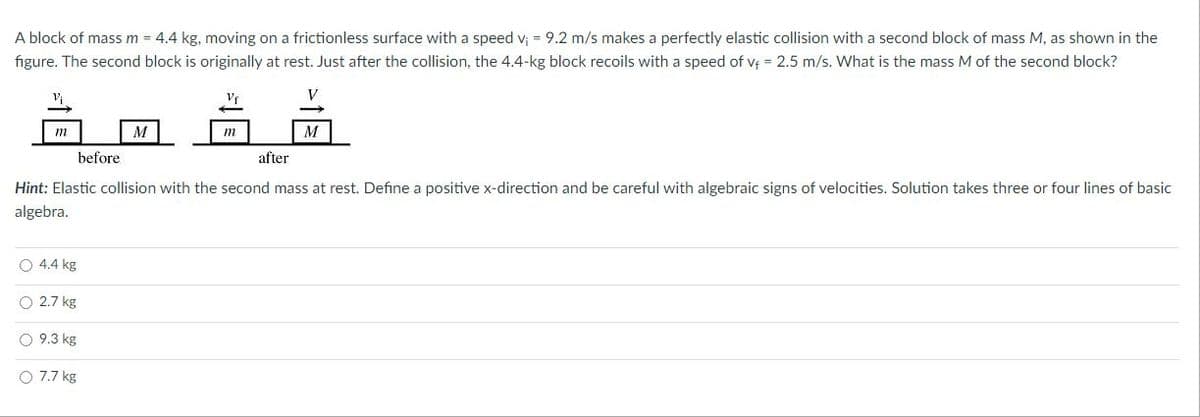A block of mass m = 4.4 kg, moving on a frictionless surface with a speed v = 9.2 m/s makes a perfectly elastic collision with a second block of mass M, as shown in the figure. The second block is originally at rest. Just after the collision, the 4.4-kg block recoils with a speed of v = 2.5 m/s. What is the mass M of the second block? V M M before after Hint: Elastic collision with the second mass at rest. Define a positive x-direction and be careful with algebraic signs of velocities. Solution takes three or four lines of basic algebra. O 4.4 kg O 2.7 kg O 9.3 kg O 7.7 kg
A block of mass m = 4.4 kg, moving on a frictionless surface with a speed v = 9.2 m/s makes a perfectly elastic collision with a second block of mass M, as shown in the figure. The second block is originally at rest. Just after the collision, the 4.4-kg block recoils with a speed of v = 2.5 m/s. What is the mass M of the second block? V M M before after Hint: Elastic collision with the second mass at rest. Define a positive x-direction and be careful with algebraic signs of velocities. Solution takes three or four lines of basic algebra. O 4.4 kg O 2.7 kg O 9.3 kg O 7.7 kg
Physics for Scientists and Engineers: Foundations and Connections
1st Edition
ISBN:9781133939146
Author:Katz, Debora M.
Publisher:Katz, Debora M.
Chapter10: Systems Of Particles And Conservation Of Momentum
Section: Chapter Questions
Problem 31PQ: A crate of mass M is initially at rest on a frictionless, level table. A small block of mass m (m ...
Related questions
Question
100%
can you help me solve this?

Transcribed Image Text:A block of mass m = 4.4 kg, moving on a frictionless surface with a speed V; = 9.2 m/s makes a perfectly elastic collision with a second block of mass M, as shown in the
figure. The second block is originally at rest. Just after the collision, the 4.4-kg block recoils with a speed of vf = 2.5 m/s. What is the mass M of the second block?
à a å ð
V
m
M
m
before
after
Hint: Elastic collision with the second mass at rest. Define a positive x-direction and be careful with algebraic signs of velocities. Solution takes three or four lines of basic
algebra.
O 4.4 kg
O 2.7 kg
O 9.3 kg
O 7.7 kg
Expert Solution
This question has been solved!
Explore an expertly crafted, step-by-step solution for a thorough understanding of key concepts.
This is a popular solution!
Trending now
This is a popular solution!
Step by step
Solved in 2 steps with 2 images

Knowledge Booster
Learn more about
Need a deep-dive on the concept behind this application? Look no further. Learn more about this topic, physics and related others by exploring similar questions and additional content below.Recommended textbooks for you

Physics for Scientists and Engineers: Foundations…
Physics
ISBN:
9781133939146
Author:
Katz, Debora M.
Publisher:
Cengage Learning

Classical Dynamics of Particles and Systems
Physics
ISBN:
9780534408961
Author:
Stephen T. Thornton, Jerry B. Marion
Publisher:
Cengage Learning

Principles of Physics: A Calculus-Based Text
Physics
ISBN:
9781133104261
Author:
Raymond A. Serway, John W. Jewett
Publisher:
Cengage Learning

Physics for Scientists and Engineers: Foundations…
Physics
ISBN:
9781133939146
Author:
Katz, Debora M.
Publisher:
Cengage Learning

Classical Dynamics of Particles and Systems
Physics
ISBN:
9780534408961
Author:
Stephen T. Thornton, Jerry B. Marion
Publisher:
Cengage Learning

Principles of Physics: A Calculus-Based Text
Physics
ISBN:
9781133104261
Author:
Raymond A. Serway, John W. Jewett
Publisher:
Cengage Learning

University Physics Volume 1
Physics
ISBN:
9781938168277
Author:
William Moebs, Samuel J. Ling, Jeff Sanny
Publisher:
OpenStax - Rice University